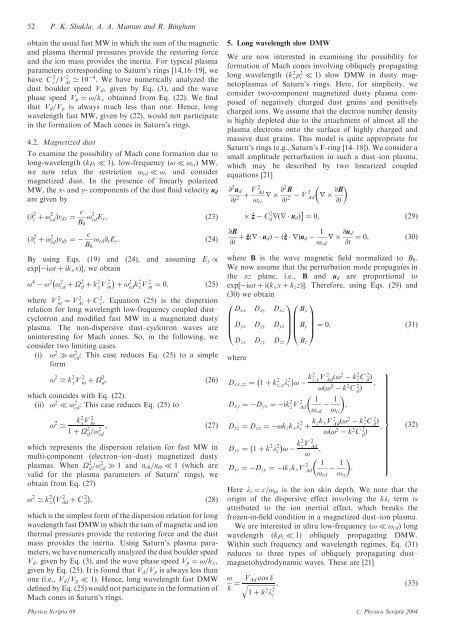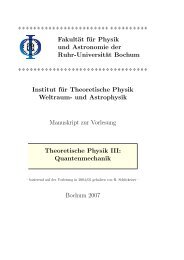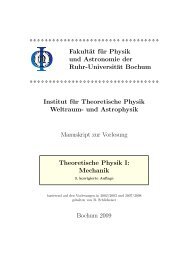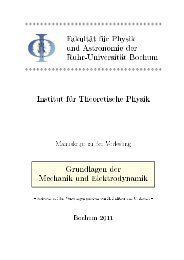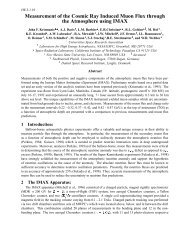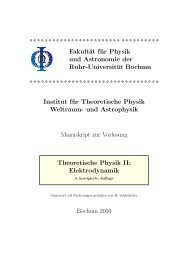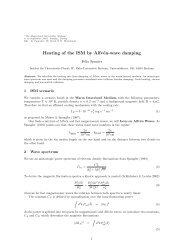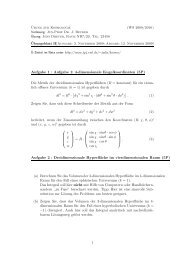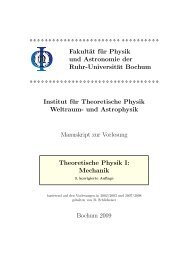PDF FILE - Theoretische Physik IV
PDF FILE - Theoretische Physik IV
PDF FILE - Theoretische Physik IV
You also want an ePaper? Increase the reach of your titles
YUMPU automatically turns print PDFs into web optimized ePapers that Google loves.
52 P. K. Shukla, A. A. Mamun and R. Bingham<br />
obtain the usual fast MW in which the sum of the magnetic<br />
and plasma thermal pressures provide the restoring force<br />
and the ion mass provides the inertia. For typical plasma<br />
parameters corresponding to Saturn’s rings [14,16–19], we<br />
have C 2 s =V Ai 2 ’ 10 4 : We have numerically analyzed the<br />
dust boulder speed V d ; given by Eq. (3), and the wave<br />
phase speed V p ¼ !=k x obtained from Eq. (22). We find<br />
that V d =V p is always much less than one. Hence, long<br />
wavelength fast MW, given by (22), would not participate<br />
in the formation of Mach cones in Saturn’s rings.<br />
4.2. Magnetized dust<br />
To examine the possibility of Mach cone formation due to<br />
long-wavelength ðk i 1Þ; low-frequency ð! ! ci Þ MW,<br />
we now relax the restriction ! cd !; and consider<br />
magnetized dust. In the presence of linearly polarized<br />
MW, the x- and y- components of the dust fluid velocity u d<br />
are given by<br />
5. Long wavelength slow DMW<br />
We are now interested in examining the possibility for<br />
formation of Mach cones involving obliquely propagating<br />
long wavelength ðk 2 x 2 i 1Þ slow DMW in dusty magnetoplasmas<br />
of Saturn’s rings. Here, for simplicity, we<br />
consider two-component magnetized dusty plasma composed<br />
of negatively charged dust grains and positively<br />
charged ions. We assume that the electron number density<br />
is highly depleted due to the attachment of almost all the<br />
plasma electrons onto the surface of highly charged and<br />
massive dust grains. This model is quite appropriate for<br />
Saturn’s rings (e.g., Saturn’s F-ring [14–18]). We consider a<br />
small amplitude perturbation in such a dust–ion plasma,<br />
which may be described by two linearized coupled<br />
equations [21]<br />
@ 2 u d<br />
@t 2 þ V 2 <br />
Ad<br />
r @2 B<br />
! ci @t 2 V 2 Ad r @B <br />
@t<br />
ð@ 2 t þ !2 cd Þv dx ¼ c B 0<br />
! 2 cd E y;<br />
ð23Þ<br />
^z<br />
C 2 d rru ð dÞ ¼ 0; ð29Þ<br />
ð@ 2 t þ !2 cd Þv dy ¼ c B 0<br />
! cd @ t E y : ð24Þ<br />
@B<br />
@t þ ^z 1<br />
ðru d Þ ð^z rÞu d r @u d<br />
! cd @t ¼ 0;<br />
ð30Þ<br />
By using Eqs. (19) and (24), and assuming E y /<br />
exp½ i!t þ ik x xÞŠ; we obtain<br />
! 4 ! 2 ! 2 cd þ 2 d þ k2 x V 2 m<br />
þ !<br />
2<br />
cd k 2 x V 2 m ¼ 0; ð25Þ<br />
where V 2 m ¼ V Ai 2 þ C 2 s : Equation (25) is the dispersion<br />
relation for long wavelength low-frequency coupled dust–<br />
cyclotron and modified fast MW in a magnetized dusty<br />
plasma. The non-dispersive dust–cyclotron waves are<br />
uninteresting for Mach cones. So, in the following, we<br />
consider two limiting cases.<br />
(i) ! 2 ! 2 cd<br />
: This case reduces Eq. (25) to a simple<br />
form<br />
! 2 ’ k 2 x V 2 m þ 2 d ; ð26Þ<br />
which coincides with Eq. (22).<br />
(ii) ! 2 ! 2 cd<br />
: This case reduces Eq. (25) to<br />
! 2 ’ k2 x V 2 m<br />
1 þ 2 ; ð27Þ<br />
d =!2 cd<br />
which represents the dispersion relation for fast MW in<br />
multi-component (electron–ion–dust) magnetized dusty<br />
plasmas. When 2 d =!2 cd 1 and n e0=n i0 1 (which are<br />
valid for the plasma parameters of Saturn’ rings), we<br />
obtain from Eq. (27)<br />
! 2 ’ k 2 x V 2 Ad þ C 2 d<br />
; ð28Þ<br />
which is the simplest form of the dispersion relation for long<br />
wavelength fast DMW in which the sum of magnetic and ion<br />
thermal pressures provide the restoring force and the dust<br />
mass provides the inertia. Using Saturn’s plasma parameters,<br />
we have numerically analyzed the dust boulder speed<br />
V d ; given by Eq. (3), and the wave phase speed V p ¼ !=k x ;<br />
given by Eq. (25). It is found that V d =V p is always less than<br />
one (i.e., V d =V p 1). Hence, long wavelength fast DMW<br />
defined by Eq. (25) would not participate in the formation of<br />
Mach cones in Saturn’s rings.<br />
where B is the wave magnetic field normalized to B 0 :<br />
We now assume that the perturbation mode propagates in<br />
the xz plane, i.e., B and u d are proportional to<br />
exp½ i!t þ iðk x x þ k z zÞŠ: Therefore, using Eqs. (29) and<br />
(30) we obtain<br />
0<br />
10<br />
1<br />
D xx D xy D xz B x<br />
B D yx D yy D yz CB<br />
B y C<br />
@<br />
A@<br />
A ¼ 0;<br />
ð31Þ<br />
D zx D zy D zz<br />
where<br />
B z<br />
D xx;zz ¼ 1 þ k 2 k 2<br />
z;x l2 i !<br />
z;x V 2 Ad ð!2 k 2 z C 2 d Þ<br />
!ð! 2 k 2 C 2 d Þ ;<br />
<br />
D xy ¼ D yx ¼ ik 2 z V 2 Ad<br />
1 1<br />
! cd ! ci<br />
<br />
;<br />
D xz ¼ D zx ¼ !k z k x l 2 i þ k zk x V 2 Ad ð!2 k 2 z C 2 d Þ<br />
!ð! 2 k 2 C 2 d Þ ;<br />
D yy ¼ 1 þ k 2 l 2 <br />
i !<br />
k 2 z V 2 Ad<br />
! ;<br />
<br />
D yz ¼ D zy ¼ ik z k x V 2 Ad<br />
1 1<br />
! cd ! ci<br />
<br />
:<br />
9<br />
>=<br />
>;<br />
ð32Þ<br />
Here l i ¼ c=! pi is the ion skin depth. We note that the<br />
origin of the dispersive effect involving the kl i term is<br />
attributed to the ion inertial effect, which breaks the<br />
frozen-in-field condition in a magnetized dust–ion plasma.<br />
We are interested in ultra low-frequency ð! ! cd Þ long<br />
wavelength ðk i 1Þ obliquely propagating DMW.<br />
Within such frequency and wavelength regimes, Eq. (31)<br />
reduces to three types of obliquely propagating dust–<br />
magnetohydrodynamic waves. These are [21]<br />
!<br />
k ¼ V Ad cos <br />
q ffiffiffiffiffiffiffiffiffiffiffiffiffiffiffiffiffi ; ð33Þ<br />
1 þ k 2 l 2 i<br />
Physica Scripta 69 # Physica Scripta 2004


